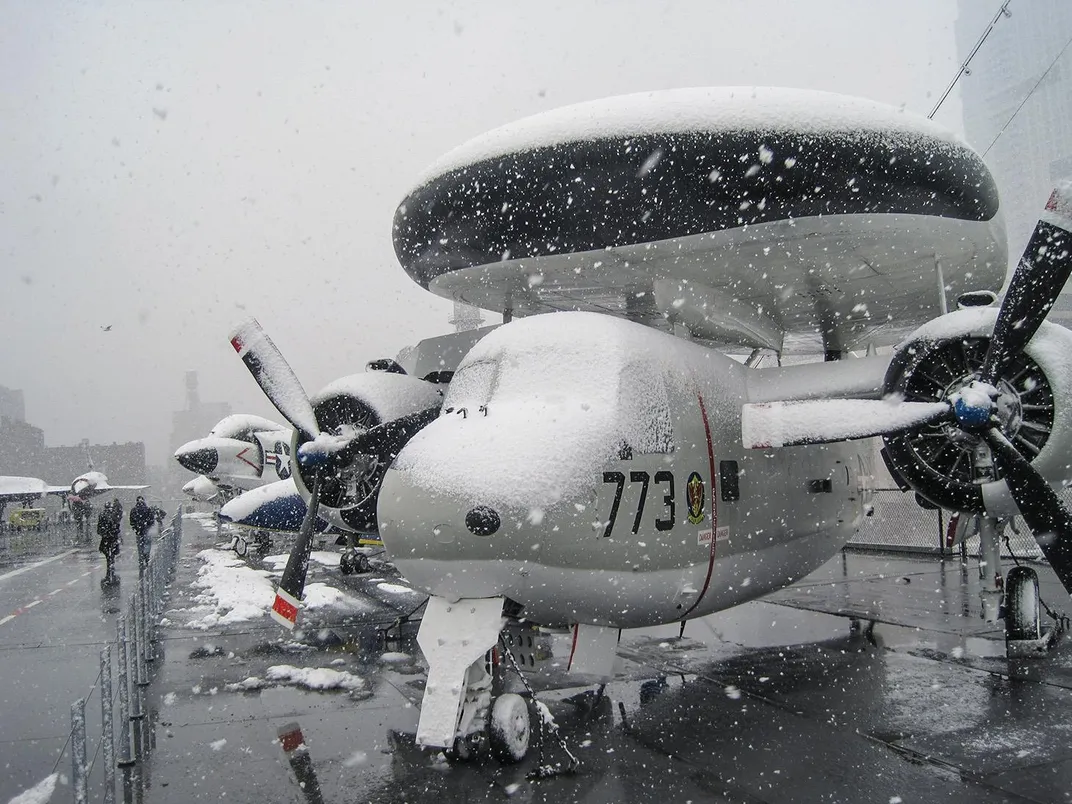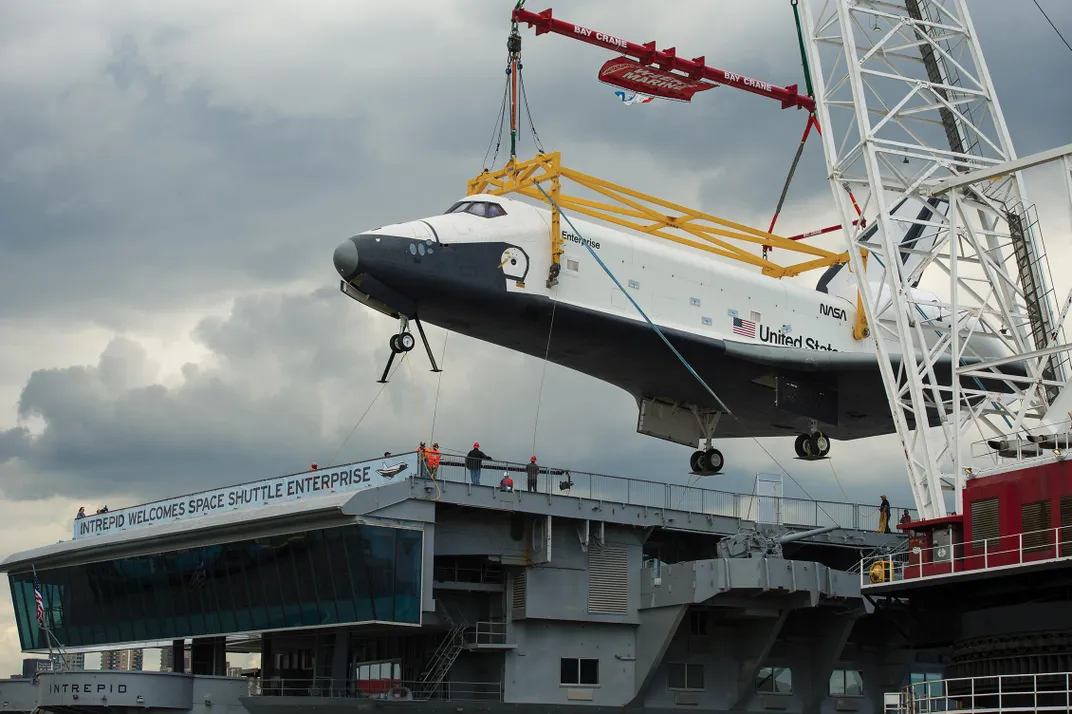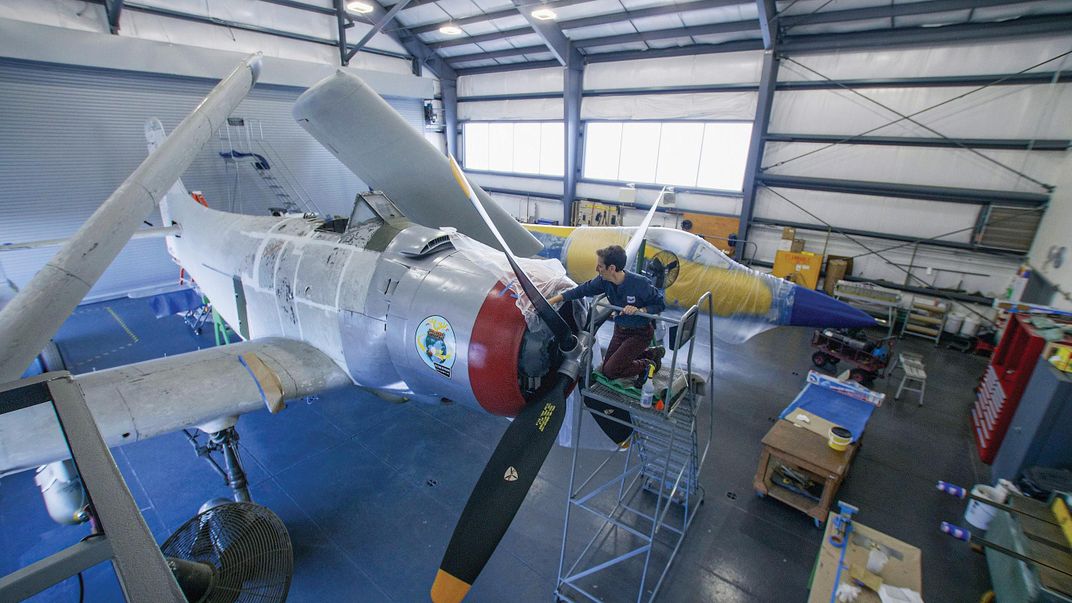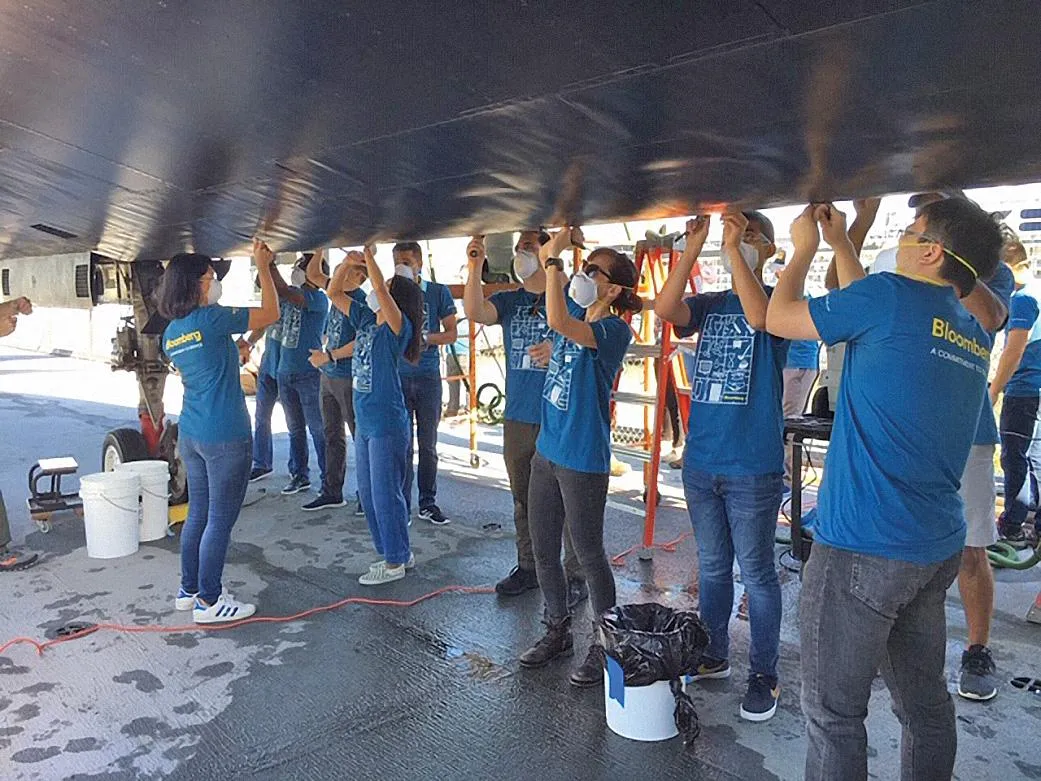Defend the Intrepid
It survived two wars, but now it faces another grave threat: the environment of New York City.
:focal(1428x3171:1429x3172)/https://tf-cmsv2-smithsonianmag-media.s3.amazonaws.com/filer/a7/f2/a7f24f10-0a47-4c62-9130-f3a00a8580e4/03f_on2021_caringforintrepid_091026_unk_0050_live.jpg)
Every vintage airplane displayed outside museum walls suffers from some degree of exposure, but the 22 machines on the flight deck of the Intrepid Sea, Air & Space Museum are parked in a special kind of hell. “I cannot think of a worse environment for aircraft,” says the Intrepid ’s aviation curator Eric Boehm. “While other aviation museums struggle with various environmental issues, it’s rare for an institution to battle so many at once, and at such extremes, as we do. Our situation is challenging.”
New York City’s blend of salt air, noxious pollution, and animal pests, combined with icy winter winds and ruthless summer sun exposure, constantly work to break these aircraft down to their most basic elements. “The simple science of it is that nature wants to convert them back to dust,” Boehm says. “We have to fight this deterioration process every day.”
The Intrepid, a retired aircraft carrier, is a veteran of combat in both World War II and Vietnam as well as the primary recovery ship for two crewed space missions. The Essex-class carrier is now moored near the heart of America’s largest city. The ship is consistently one of New York’s top attractions, drawing hundreds of thousands of visitors from all over the world. It’s popular with locals too; the Intrepid is the city’s largest military museum and part of Manhattan’s distinct community. “Even if you’re not into the subject matter,” relates a popular travel website, “it’s irresistibly absorbing and impressive.”
Unfortunately, the classic combat aircraft arrayed on the flight deck absorb more than attention.

Top on the list of aircraft-eating elements is the salt air. The Intrepid is berthed at Pier 86 on the Hudson River. The former moorage spot for United States Lines’ ocean-liners is far enough downriver that the water there is more than brackish—it’s Atlantic Ocean salty. The damp salt air burns through magnesium, quickly oxidizes steel, and speckles the aluminum skins of the aircraft with patches of white, flaky corrosion. “On the aircraft, you have to catch it fast,” says Boehm. “We remove the paint, extract the bad area with sanding, grinding, or sometimes even a newly built replacement part. You almost have to treat it like cancer. You can’t let it grow.” Primer, aircraft-grade paint, and anti-corrosion chemicals are a regular part of the maintenance staff ’s arsenal, used both on the exterior and interior of the airplanes.
Another condition harmful to the Intrepid ’s aircraft is ever-present pollution. Long ago, sailors knew if you wanted to take care of marine growth on the bottom of your vessel, you simply anchored in the Hudson. The chemical-infused water would kill almost anything. While years of improvement have left the water and the air surrounding New York City cleaner than it has been in decades, the sprawling metropolis around the Intrepid still constantly spews a dirty gray film. It comes from a combination of the last of the city’s oil-burning heaters, commercial cooking, large concentrations of local industry in New York and New Jersey, and thousands of trucks, cars, boats, and buses. “Sunny months are our washing months,” says Boehm. “Someone is almost always up on a lift, harnessed in, scrubbing away at a wing or tail. In between extensive tip-to-tail baths, we spot wash. My staff knows that poo-spattered planes are not acceptable. That comes off every day.”

City wildlife is a third constant problem. Improvement in New York’s environment actually means more animals have come back to the Hudson in the 2000s. Recently, staffers have spotted peregrine falcons perched in the jumble of antennas at the top of the Intrepid ’s island. It’s too exposed for them to happily nest; they are there looking for a snack. The falcons are at the top of a very simple food chain. Tourists drop chips and popcorn, which attracts pigeons. The pigeons, in turn, entice the falcons. Boehm likes both ends of this chain, but he has no use for the middle man.
Hundreds of the city’s most prevalent and ill-mannered inhabitants perch on the wings and tails of the gleaming jet fighters. Though they are fliers themselves, the pigeons seem to have no abiding respect for aviation history. “Besides the fact that it looks just terrible,” says Boehm, “what these winged pests leave behind is acid. Their poop literally contains doses of uric acid.”
While pigeons and falcons come to dine, the starlings are ready to move in. Aircraft cleaning crews scout for the messy, mouthy birds on their rounds, discouraging sleepovers in the cramped but temptingly cozy wheel-wells and air intakes of the aircraft. Many of the best spots are closed off with wire mesh. Bees, too, are known to periodically set up shop inside the airplanes, unhindered by the anti-bird installations.
While insects are the smallest winged nuisances, Canada geese are the largest and perhaps the rudest, regularly converting food into noise and other unpleasantries left on the carrier deck. They commonly don’t hurt the museum’s static aircraft but they have been known to do much worse. Captain “Sully” Sullenberger’s airliner skidded to a stop in the Hudson near Pier 86. “They found the plane’s goose-choked left engine just a few hundred yards off the Intrepid ’s stern,” says Boehm. “We’re going to display it in an upcoming exhibit.”
The environment the Intrepid experiences is so unforgiving that paint companies sometimes donate supplies to the museum in order to study the results of their product after a year or two in purgatory.
“Every year we assess what planes need to be freshened up and schedule them for the shop,” Boehm says. “We used to tent each aircraft but now we have a 5,000-foot hangar just aft of the carrier’s island.” They repaint two or three airplanes each year.
Like any good curator, Boehm thinks about preservation in terms of decades, or even centuries. “It’s impossible to keep these aircraft on display forever,” he says. “But, without a doubt, they will be here when you visit next year. Or the year after that, or the year after that … .”

